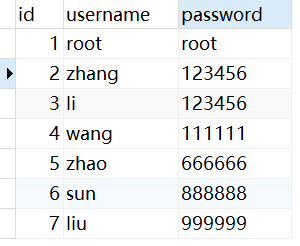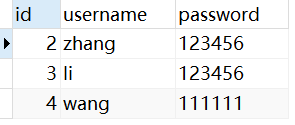本文将介绍如何如何在 Java 中进行分页查询。
一、LIMIT
1. LIMIT
LIMIT 可以用于从返回结果中筛选指定部分的数据。
用法如下:
1
| SELECT * FROM 表名 LIMIT [index], number
|
其中,
index:索引,表示返回结果中第一条记录的索引值
从 0 开始计算
number:个数,表示返回的记录个数
如果填入两个参数,则第一个参数为 index,第二个参数为number;
如果填入一个参数,则 index 默认为 0,即从第一个开始,传入参数为 number
假设有记录如图所示:

1
| SELECT * FROM 表名 LIMIT 1, 3
|

1
| SELECT * FROM 表名 LIMIT 0, 2
|

1
| SELECT * FROM 表名 LIMIT 2
|

2. SQL 中的 LIMIT
1
| SELECT * FROM 表名 LIMIT (当前页数 - 1) * 每页条数, 每页条数
|
3. Mybatis 中使用 LIMIT
抽象方法:
1
| List<User> getUserListByLimit(Map<String, Integer> map);
|
映射配置:
1
2
3
| <select id="getUserListByLimit" parameterType="map" resultType="pojo.User">
select * from user limit #{index}, #{pageSize}
</select>
|
测试代码:
1
2
3
4
5
6
7
8
9
10
11
12
13
14
15
16
17
18
19
|
sqlSession = MyBatisUtils.getSqlSession();
mapper = sqlSession.getMapper(UserMapper.class);
HashMap<String, Integer> map = new HashMap<>();
map.put("index", (2 - 1) * 2);
map.put("pageSize", 2);
List<User> userList = mapper.getUserListByLimit(map);
for (User user : userList) {
System.out.println(user);
}
sqlSession.close();
|
执行结果:

二、物理分页和逻辑分页
物理分页的做法是:根据要求向数据库查询指定的数据;
逻辑分页的做法是:查询全部结果,放入内存中,截取指定的部分返回
物理分页通过数据库语句实现(例如 SQL 中的 LIMIT);
逻辑分页通过 Java 代码实现
物理分页每次都要访问数据库,对数据库负担较大;
逻辑分页只需要访问一次数据库
物理分页占内存较小;
逻辑分页一次性读取所有数据,因此需要占用较大的内存空间
物理分页每次都访问数据库,因此实时性较强;
逻辑分页将数据保存在内存中,无法保证数据的时效性
物理分页适用于数据量较大、更新频繁的场合;
逻辑分页适用于数据量较小、数据稳定的场合
三、RowBounds
不推荐使用
RowBounds 是逻辑分页,查询全部结果,截取指定的部分返回
抽象方法:
1
| List<User> getUserListByRowBounds();
|
映射配置:
1
2
3
| <select id="getUserListByRowBounds"resultType="pojo.User">
select * from user
</select>
|
测试代码:
1
2
3
4
5
6
7
8
9
10
11
12
13
14
15
|
sqlSession = MyBatisUtils.getSqlSession();
RouwBounds rouwBounds = new RouwBounds(index, pageSize)
List<User> userList = sqlSession.selectList("XxxMapper全限定类名.getUserListByRowBounds", null, rouwBounds)
for (User user : userList) {
System.out.println(user);
}
sqlSession.close();
|
四、PageHelper
PageHelper 是逻辑分页,根据要求向数据库查询指定的数据
1. 什么是 PageHelper ?
MyBatis 分页插件 PageHelper
PageHelper 是 MyBatis 的一款分页插件。
2. 集成
(1) 引入
在 pom.xml 中添加如下依赖:
1
2
3
4
5
| <dependency>
<groupId>com.github.pagehelper</groupId>
<artifactId>pagehelper</artifactId>
<version>版本号</version>
</dependency>
|
(2) 配置
法 1:
修改 Mybatis 配置文件 (mybatis-config.xml) 如下:
1
2
3
4
5
6
7
8
9
10
11
12
13
14
15
16
| <?xml version="1.0" encoding="UTF-8" ?>
<!DOCTYPE configuration
PUBLIC "-//mybatis.org//DTD Config 3.0//EN"
"http://mybatis.org/dtd/mybatis-3-config.dtd">
<configuration>
···
<plugins>
<plugin interceptor="com.github.pagehelper.PageInterceptor">
<property name="param1" value="value1"/>
<property name="param2" value="value2"/>
<property name="param3" value="value3"/>
</plugin>
</plugins>
···
</configuration>
|
法 2:
修改 Spring 配置文件如下:
1
2
3
4
5
6
7
8
9
10
11
12
13
14
15
16
17
18
19
20
21
22
| <?xml version="1.0" encoding="UTF-8"?>
<beans xmlns="http://www.springframework.org/schema/beans"
xmlns:xsi="http://www.w3.org/2001/XMLSchema-instance"
xsi:schemaLocation="http://www.springframework.org/schema/beans
http://www.springframework.org/schema/beans/spring-beans.xsd">
<bean id="sqlSessionFactory" class="org.mybatis.spring.SqlSessionFactoryBean">
<property name="plugins">
<array>
<bean class="com.github.pagehelper.PageInterceptor">
<property name="properties">
<value>param1=value1</value>
<value>param2=value2</value>
<value>param3=value3</value>
</property>
</bean>
</array>
</property>
</bean>
</beans>
|
参数:
详见 如何使用分页插件 。
3. 简单集成
在 SpringBoot 中可以使用 pagehelper-spring-boot-starter 来更方便地集成 PageHelper。
(1) 引入
在 pom.xml 中添加如下依赖:
1
2
3
4
5
| <dependency>
<groupId>com.github.pagehelper</groupId>
<artifactId>pagehelper-spring-boot-starter</artifactId>
<version>版本号</version>
</dependency>
|
(2) 配置
在 application.yml 中增加配置信息如下:
1
2
3
4
| pagehelper:
helperDialect: mysql
reasonable: true
supportMethodsArguments: true
|
详见 如何使用分页插件 。
4. 使用方式 1
在 Service 中调用 mapper 的查询方法之前执行 PageHelper 的 startPage 方法:
需要注意的是:
有且仅有紧跟在 PageHelper 的 startPage 方法之后的第一个 Mybatis 查询方法才会被分页。
1
2
3
4
5
6
7
8
9
10
11
12
13
| @Service
public class XxxServiceImpl implements XxxService {
···
@Override
public List<Xxx> getAllXxx() {
PageHelper.startPage([pageNum], [pageSize]);
return XxxMapper.getAllXxx();
}
···
}
|
5. 使用方式 2
为 Mapper 中的查询方法增加参数:pageNum 和 pageSize,PageHelper 会自动读取参数并进行分页。
如果需要更改参数名,可以通过 params 配置实现
1
2
3
4
5
6
7
8
9
10
11
12
13
14
15
| @Mapper
public interface XxxMapper {
List<Xxx> getAllXxx();
List<Xxx> getAllXxx(int pageNum, int pageSize);
}
|
参考



